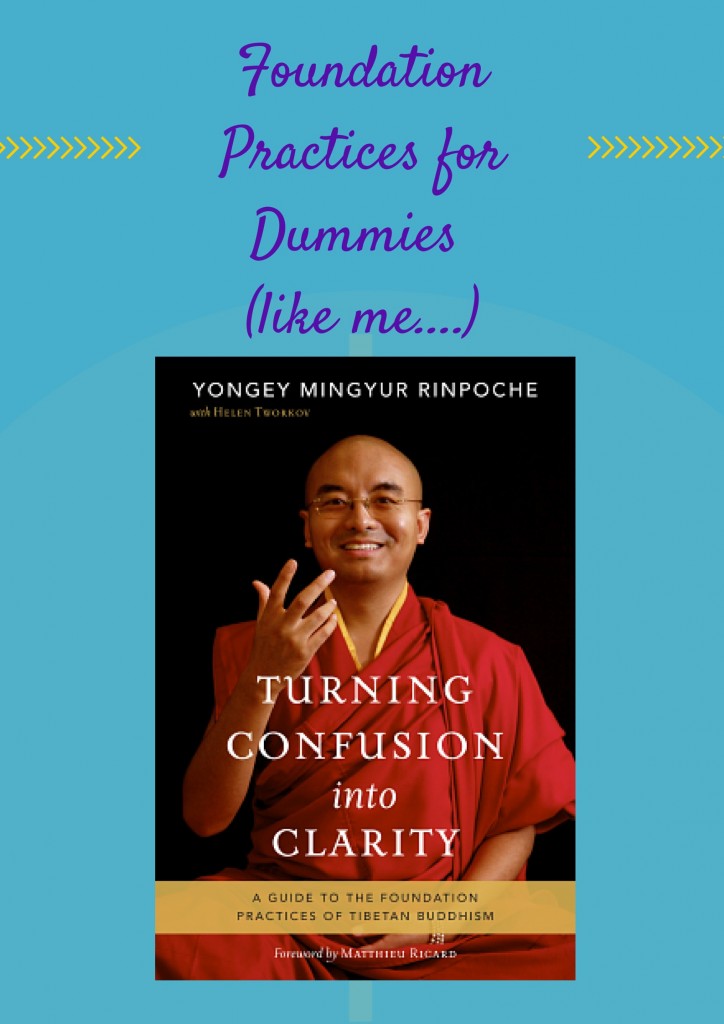Book Review: “Turning Confusion into Clarity”

Yongey Mingur Rinpoche’s latest book “Turning Confusion into Clarity” did just what the title promised.
Well, at least the first two sections….
As a student and practitioner who is getting ready to dip a toe into ngondro practices (steady there, I still have a little ways to go), this book came at the right time as I study and meditate upon the four common foundation practices (those involving contemplation upon precious human birth, impermanence, karma and our ever-loving dear friend - suffering). As mentioned in a previous post, I underlined a good majority of this book.
Mathieu Ricard provides the foreword, and rightfully so, as he is a student of Yongey Mingur Rinpoche’s (who in turn, is also the heart-son of several of Ricard’s root spiritual masters). He speaks greatly to the importance of these advanced teachings and cites other prominent teachers who have written similar works and focused on these teachings throughout their lives.
Based on a series to talks delivered in 2004 in British Columbia (yay Canada!), “Turning Confusion into Clarity” features many personal stories of his life and those of Yongey Mingur Rinpoche’s father, Tulku Urgen Rinpoche and his brother, Tsoknyi Rinpoche. Other great teachers he studied under and the great masters from before his time such as Tilopa and Naropa are prominent within its pages as well.
Rinpoche shares his heart and speaks to experiences from his spiritual path and his experience of ngondro. Overall, this book is a humorous and joyful glimpse into both his early days as a young monk and as a present-day teacher and author. The personal stories really do make the book one which is a thoroughly enjoyable read.
Part One of the book lays the groundwork and is titled “Entering the Path.” It’s an examination of what materials will be covered and speaks greatly to the nature of mind, and its movement from confusion to clarity. The four thoughts that turn the mind to dharma are featured as well as a note on empowerments and transmission. Rinpoche then gives provides and overview of the four practices of the unique ngondro, setting the stage for a more in-depth examination in the chapters to follow.
Meditation is examined fully in “Turning Confusion into Clarity” in that Rinpoche both provides advice on how to do it- both from a physical and mental standpoint. Several meditation and contemplation exercises are offered throughout the book and serve to develop the stability and understanding required for the more advanced practices that a student will encounter on the path.
Part Two gets into the Four Common Foundation Practices and has a chapter dedicated to each: precious human birth, impermanence, karma and suffering. This provides details on the first part of ngondro or the ‘common’ or ‘outer’ ngondro. I found this section of the book to be extremely powerful as Rinpoche’s ability to tell magnificent stories of the joys and pitfalls for Buddhist practice shines through. He is adept at expressing the challenges of Western students and cites many references that resonated personally with me.
This section of the book also gets into topics such as the six realms of samsaric experience, practicing with the eight freedoms, the four restrictive conditions of the human realm and some of the most profound writing I’ve read on impermanence in my, well impermanent life. It’s strangely comforting to hear the stories of Rinpoche’s panic attacks and fear of death given that I too have these issues present in my life. I love this section for what it offered to me.
The chapters on karma and emptiness were also highly informative as oft-misunderstood terms by non-Buddhists and Buddhists alike. To have it distilled in a way that made sense made it an important read, and again, hearing Rinpoche speak to his own confusion of these concepts, only to be told by his teachers that many students get tripped up by it, was heartening.
Part Three is where things get “whoooshbang! Woo hoo. Strap in and put on your flight suit because we’re going on a wild ride. What is that glowing mechanical bull doing here? Zip Zap Wowsa” kind of stuff. These are advanced teachings folks so be forewarned. If you are not into getting to know ngondro, then half of the book isn’t really going to be your cup of tea, at least perhaps at this point on your path.Don’t be afraid though, and go in with an open mind.
Personally, I’m looking forward to this book evolving with me (and me with it) as I move through the practice path. For now, I’m content with reading and becoming aware of these advanced practices, without engaging just yet. “Patience young grasshopper,” I whisper to myself.
Reality check. This book is ‘A Guide to the Foundation Practices of Tibetan Buddhism’ and not meant to substitute the fine wisdom of a teacher’s guidance. I read it knowing that most of what has been described it not yet for my consumption, but rather for reading through for when the time is right. The materials became a bit overwhelming at times, but it was good to have some exposure to these teachings and visualizations. In a nutshell, this section contains several chapters where Rinpoche introduces the various ngondro practices such as refuge, purification mantra and guru yoga.
Back to the mundane reality of writing this book review…
Overall, I wholeheartedly recommend “Turning Confusion into Clarity” for those students who are serious about Tibetan Buddhism and have some semblance of an interest in learning more about the foundational practices. It’s not a book for beginners. Nope.
In my case, the book presented itself at the right time. It’s good to know the general direction of where I’m headed, so “Turning Confusion into Clarity” is a great roadmap for my journey towards ngondro. No doubt, I will be using it is a reference along the way.

Comments are closed.